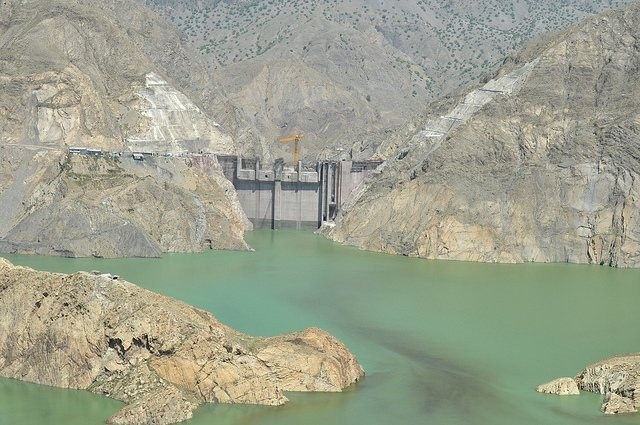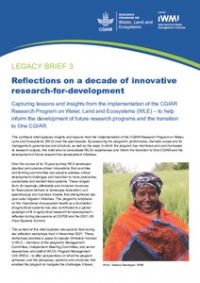The answer is—as usual—that it depends!
This blog is part of WLE’s participation in the conference on "Water in the Anthropocene: Challenges for Science and Governance. Indicators, Thresholds and Uncertainties of the Global Water System". A series of blogs have been written click here for more information
Many large river basins support both—energy production from hydropower and withdrawals for irrigated food production (in addition to many other uses, such as for households and industries, fisheries and the environment). Reservoirs constructed for hydropower production could easily serve irrigation systems as water can be available ‘on-demand’ through releases from the dam, rather than having to wait for runoff from glaciers, snowmelt or precipitation generated elsewhere.
Reservoir releases are non-consumptive and thus the volume of water used for energy production would still be available for other purposes. Moreover, in most cases hydropower reservoirs are located in the upstream, hillier parts of river basins, whereas irrigation systems—particularly large systems—require flat areas for optimal development. Finally, energy demand from hydropower is often high in the hot/summer season when crops are also thirstiest, supporting co-releases for both purposes. Thus, there should be no tradeoffs between these two uses.
Unfortunately, the story is not as simple as that; and is becoming increasingly complex due to rapidly growing pressures on global water resources. Two sample basins are used to illustrate the hydropower-water-food tradeoffs that do exist: the Indus (see presentations by Ringler and Robinson) and Aral Sea Basins.
The Indus River Basin
The Indus River Basin supports the largest contiguous irrigation system in the world, covering 16 million hectares, using about 123 km3 of water roughly half from leaky canal systems and the remainder from groundwater supplied by the canal systems. This volume accounts for about 70 percent of total basin runoff and contributes 80-90 percent of Pakistan’s food production. Four large hydropower stations: three with reservoirs Mangla (1000 MW), Tarbela (3478 MW) and Chashma (184 MW) and one run-of-the-river dam (Ghazi-Barotha, 1,450 MW) provide almost all of the hydropower generated in the basin, accounting for 11 percent of total hydropower potential.
In Pakistan, irrigation has priority access to water and energy generation comes second. At the same time, the country suffers from massive energy shortages. More than one third of households in Punjab, which were recently interviewed under the Pakistan Strategy Support Project led by the International Food Policy Research Institute (IFPRI), reported massive downtime of power. Energy-intensive industries (which comprise most industries) have either left the country or built their own energy generation capacity at enormous cost which has led to serious damage to Pakistan’s economy.
While the root cause of poor electricity supply in Pakistan is primarily poor government policy, additional hydropower generation could help relieve some of the power shortages. An analysis using a river basin model for the Indus basin finds that maximizing annual hydropower benefits (rather than prioritizing irrigation) would increase total benefits from hydropower generation from USD$2.9 to US$3.0 billion, a minor increase; while agricultural profits would decline by a similar amount—a zero-sum game! Thus, the playing field at the current low level of storage development and release rules is small. If, the rule curves would be altered toward favoring hydropower, and/or if the focus would be on the winter season, where runoff is lowest, the tradeoff would be somewhat more pronounced.
However, if two long planned reservoirs would come online, more than doubling production capacity, and if energy generation would be prioritized, then agricultural production could decline to a third of previous levels; while energy production, which would already almost double with the new storage, could be further increased by almost 10 percent. Thus, while new storage is sorely needed in the basin to more flexibly respond to growing water supply variability and to help respond to energy shortages, it is important that the resulting growing tradeoffs between irrigation and hydropower are considered and changes in water allocation rules are carefully assessed.
The Aral Sea Basin
The hydropower–irrigation tradeoff in the Aral Sea Basin in Central Asia is much better known and chiefly concerns upstream Kyrgyzstan and downstream Uzbekistan on the Syr Darya River. Here, energy demand is highest in the winter season, chiefly for heating in this relatively cool area but also for cotton processing; while irrigation demand is largest during the summer season. The hydro-technical infrastructure in the basin was designed in Soviet times to provide water and some hydropower-generated energy to irrigated lands downstream during the summer months. In turn, downstream countries compensated for the winter energy demands of upstream countries, providing them with gas and oil commodities at low prices.
However, after independence, this upstream-downstream collaboration ceased. Downstream countries increased energy commodity prices following global price trends, which led to frequent payment delays by upstream nations. Upstream countries, in turn, demanded higher prices for electricity supply during summer months. Eventually, upstream countries decided to release water from the reservoirs during the winter period to generate hydroelectric power to satisfy increased domestic demands for heating, and stored summer flows. Large winter releases threaten the water infrastructure downstream and have reduced irrigation water availability and thus food and income security in the downstream regions, resulting in conflict between upstream and downstream water users and the complete failure of the water-energy cooperation efforts in Central Asia.
What are the lessons to be learned from these two examples under a future of growing demand for/scarcity of water, energy, land and food? First, there are always tradeoffs for water and other resources among competing users and users, even if these are not necessarily evident. Reservoir operation rules set to support hydropower will leave less water for irrigation than operation rules favoring food production. A tradeoff analysis using tool that correctly accounts for these tradeoffs can help provide useful insights for power generators and irrigation operators alike. Once tradeoffs are quantified, it’s important to develop alternative investment and policy options to reduce these tradeoffs. Examples in the Indus could be to build more storage and in the Aral Sea Basin for the lower basin countries to resume selling gas for winter heating to the upstream countries in return for summer irrigation releases. But there are many more alternative options that could be developed to reduce tradeoffs across the water-energy-food divide.
We welcome other views on how we can better understand and use trade-off analysis in the real world to influence decisions. Other examples and discussions as to the challenges and solutions are welcome here.
For more information, you may view presentations from the GWSP Water in the Anthropocene Conference here:
Modeling the water-energy-food nexus in the Indus River of Pakistan presented by Claudia Ringler
Modeling Economywide Impacts of Water Policies in Pakistan presented by Sherman Robinson
Reducing Water and Energy Tradeoffs by increasing Water and Energy Productivity: presented by Akmal Karimov





/index.jpg?itok=EzuBHOXY&c=feafd7f5ab7d60c363652d23929d0aee)















Comments
I think that you were right on with this article. You put a nice twist to it. Very valuable information Claudia.